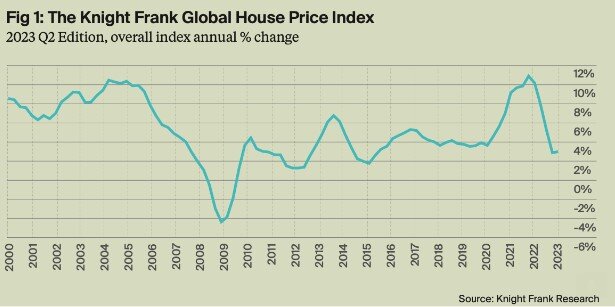According to Knight Frank’s latest Global House Price Index, global house price growth ticked up to 3% in Q2 of 2023, up from 2.9% in the previous quarter. About a third of markets saw prices decline during the most recent three months, narrowing from four in ten over the past year.

Liam Bailey, global head of research at Knight Frank reports strong demographic trends in major markets, limited inventory of houses for sale, and significant delays to new build projects are all providing structural support for pricing – especially in markets like Australia, the US and Canada – which have seen price growth of 2.9%, 3.7% and 6.1% over the past quarter.
How far conditions improve will be limited by borrowing costs. Even if central bankers in key markets opt to refrain from raising interest rates further, the effects of past tightening will continue to work its way into the system. We expect pressure on market liquidity and transactional activity to continue well into 2024.
Leaders and laggards
Turkey leads Knight Frank’s index for annual growth once again (up 96%), with nominal prices boosted by sharp underlying inflationary pressures. Lithuania follows (15.3%), with the south-eastern corner of Europe dominating the remainder of the top five spots in our ranking – with Croatia (14.0%), Greece (14.0%), and North Macedonia (12.9).
South Korea, Sweden, Finland, New Zealand, and Hong Kong are currently experiencing the largest rates of price falls – falling between 12.8% and 8.7% over the past 12 months. However, even at this end of Knight Frank’s ranking, only Sweden saw prices fall in the most recent quarterly period.
The easing of downward pressure on house prices will be welcomed by many homeowners, but a full recovery is still a long way off. The 3.0% average rate of growth recorded this quarter is still the lowest rate since Q3 2015, when European markets were still recovering from the European Debt Crisis.
One of the consequences of higher interest rates has been a broad-based decline in investment activity across most economies, and housing investment, says Knight Frank. The impact of this lack of investment in new housing stock is being clearly revealed in rental markets, with global rents rising at three times their pre-pandemic rate according to our latest Prime Global Rental Index. Unless there is a significant structural shift in housing delivery, the same pressures will act to push house prices higher again as interest rates fall in 2024 and into 2025.


